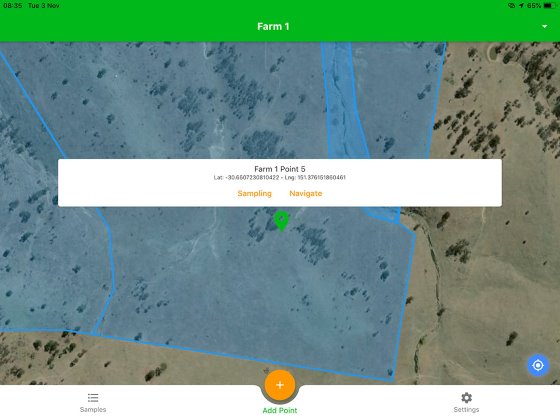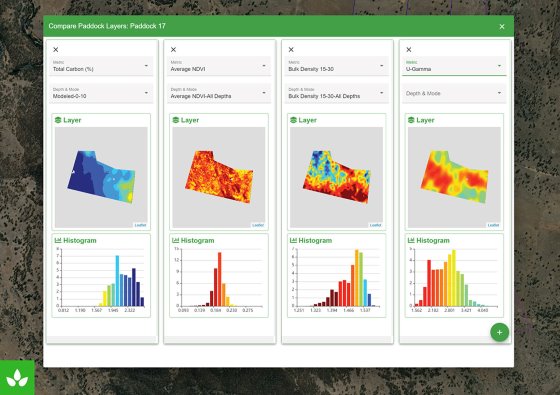Remote vision data does not offer sufficient information for the accurate application of fertiliser, says CEO and founder Sam Duncan of Australian company FarmLab. “People ask us all the time whether this could work for them for the application of nitrogen or phosphorus. But we have a firm belief that you can‘t. You need some level of soil sampling.“
A technology like NDVI can be used, Sam Duncan explains. “You can create zones with it, but you shouldn’t use it by itself to apply fertiliser. You end up with a zone map with areas of high, medium or low biomass. And if you apply your fertiliser to the area with low biomass, you may be overapplying your fertiliser. Because there could be other problems, like a water deficiency. You can’t just look at what’s happening above the ground. Comparing remote visions results with soil sampling usually shows a poor correlation.”

Long-term impact
FarmLab has built its technology, that works with a mobile app, to show farmers the long-term impact of their choices. “That helps them to make better decisions”, Duncan says. “If you look at increasing fertiliser usages over time and you‘ve got five years of a history, you can identify if there is something else going on that’s contributing to that increase in fertiliser-use. That’s where things such as carbon, rainfall and clay content come into play.”
Cheaper tests
FarmLab kept its technology simple and cheap. “In Australia soil testing is still expensive”, Duncan explains. “Because of the labour involved. We get wholesale prices through our partner-labs, so we can offer the tests about 20% cheaper than what the consumer would pay the lab directly.” FarmLab soil tests start at AUS 45 dollar per test.
FarmLab’s technology also resolves known statistical and logistical challenges. “Statistically you have to make sure you take the samples from the right spot in the paddock to make the right composite sample.”
Historical soil sample data
To make this easier for farmers, FarmLab worked with the University of Sydney to take historical soil sample data gathered from individual locations through its agronomist app and mapped it out over whole farms and regions, generating insights into soil health across wide areas of Australia’s farmland.
With this information and out of the box datasets FarmLab helps agronomists to create zones or strata to identify on what information the samples should be based on, e.g. yield or carbon. “We can then be more accurate in the application of fertiliser”, Duncan says. “The whole point of sampling is to diagnose an issue or to apply an input and to identify what rate to apply on what location.”

Growing interest in VRA
The interest in variable rate application (VRA) is growing in Australia. Currently about 20% of Australian growers use VRA. Agronomists can put FarmLab’s data into a variable rate spreader for application of nitrogen at a set rate.
“But farmers who are just starting with soil sampling, take the process in small steps”, Duncan explains. “They can’t go from just getting the first data to using a variable rate spreader. A lot of our clients don’t use VRA. They start with a single test across the fields and choose a single rate first. Then they work their way through the process. And VRA does not work for certain crops because there is no high return. But you don’t need to go that far to get economic benefits.”
With soil testing agronomists get a good accuracy of what to apply to get the optimal usage, on the base of the major soil type or the major deficiency. “This is critical to know if you want to reduce the amount of fertiliser that is being used. Because a lot of farmers do overapply their fertiliser”, Duncan points out.
This also works for large farms. Sam Duncan says one of his clients chose to go for strategic sampling across his entire farm of 1400 hectare. In this mixed cattle-cropping operation FarmLab and the farmer looked at the areas where they found high fertility over several seasons and started to crop more intensively on these areas.

Sam: “The farmer used a variable rate application and as the years progressed ended up with a big picture that clearly showed where to focus on, with great results. Farmers often have high and low performing areas and it is vital to know where they are.”
30% cost savings
On average FarmLab saves farmers about 30% of their costs by cheaper sampling costs and reduced fertiliser input, is the experience of FarmLab. On large scale farms with broadacre cropping, the average savings are usually between 15% to 20%. “That’s simply by better understanding the soil type”, Sam says. “And therefore making better fertiliser decisions.”


